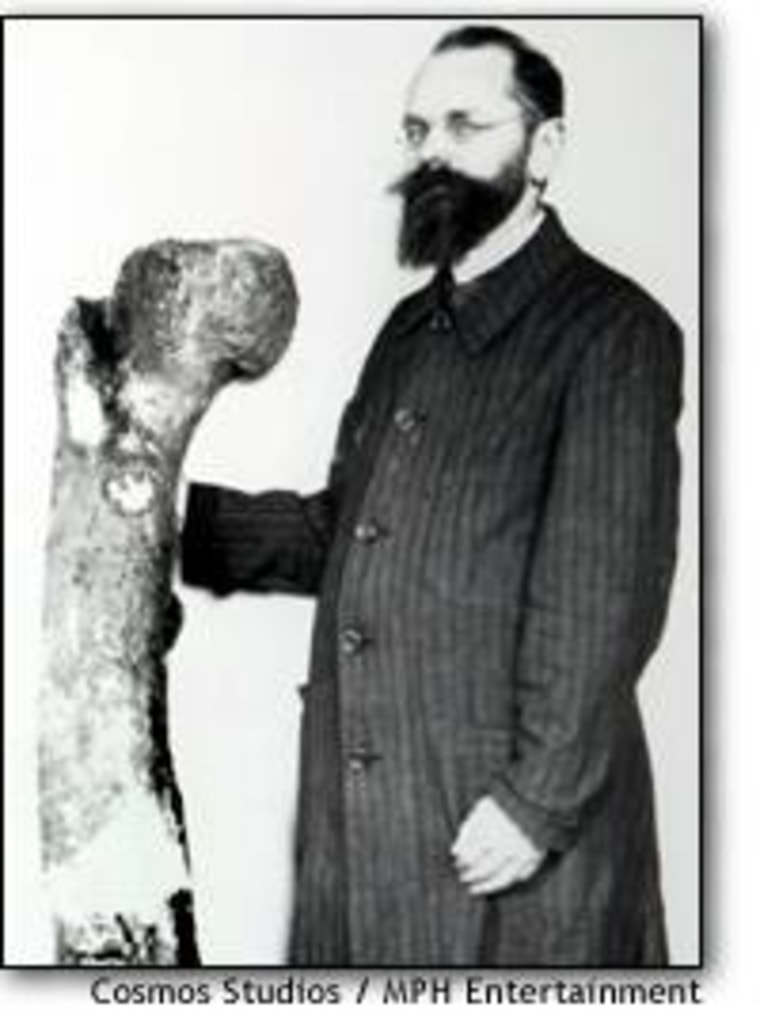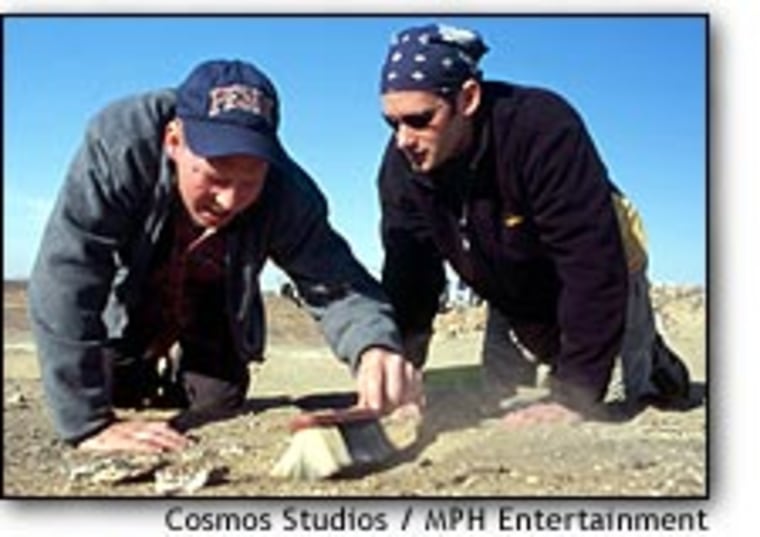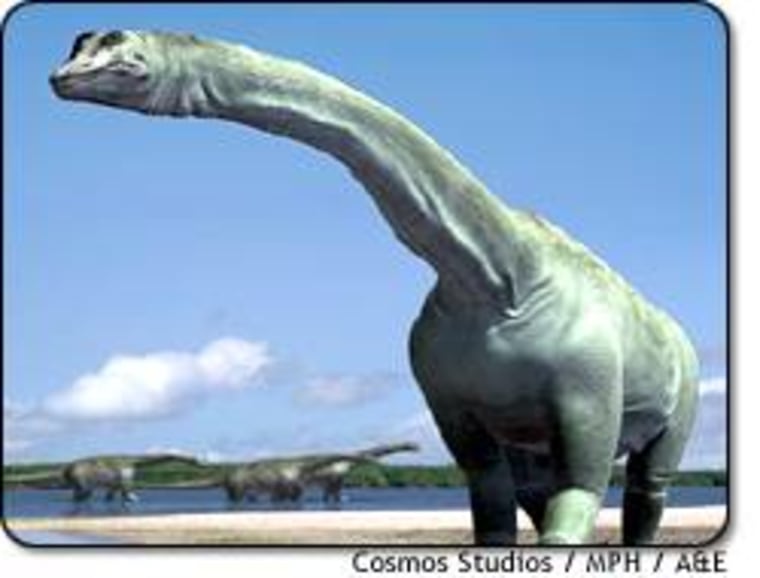The tale reads like an “Indiana Jones” sequel: A hoard of precious dinosaur fossils is discovered in the sands of Egypt and taken to Germany, only to be destroyed by Allied bombs during World War II. Decades later, a team of young paleontologists returns to Egypt and digs up more bones from the “lost dinosaurs,” including one of the biggest finds ever recorded.
The scientific confirmation came with the publication of the team’s research in the June 1 issue of Science, describing Paralititan stromeri, a new genus and species of giant dinosaur that apparently ranks as the second-biggest ever found, at a site that was on an equatorial tidal channel 94 million years ago but is now in the heart of the Egypt’s Western Desert.
The best way to begin the screenplay, however, would be in the early 1900s, when German expeditions led by Ernst Stromer first found the bones of smaller dinosaurs around the Bahariya Oasis, about 200 miles southwest of Cairo.
Stromer brought his fossils back to Munich for study and wrote papers about the discoveries between 1915 and 1936. But in 1944, the Allied bombing largely destroyed Stromer’s collection, and no professional paleontologists returned to the Bahariya dig — that is, until two years ago.
“We all knew about Stromer,” said Joshua Smith, the 31-year-old University of Pennsylvania Ph.D. candidate who led the return to Bahariya. “Every first-year paleo graduate student knows about Stromer.”

He speculated that others may have passed up the old site because of the hassle of working with Egyptian authorities, or because there were more fertile fields for fossil-hunters. But it so happened that some colleagues of his were already working on other projects in the Western Desert. So in February 1999, he was able to take a look around Bahariya.
“It quickly became obvious that there were a lot of bones,” including some that could break new scientific ground, he said.
But where would he get the financing for a full-fledged dig? “These are $50,000 to $60,000 expeditions at a minimum,” Smith told MSNBC.com. “Nobody gives graduate students that kind of money.”
The payoff pitch
Following the advice of friends, Smith and his team turned to MPH Entertainment, a 5-year-old film company that provided seed money for a Bahariya expedition. MPH struck a deal with Cosmos Studios, headed by Ann Druyan, the widow of astronomer/author Carl Sagan. Druyan hailed the effort as “a gripping Indiana Jones-style adventure story in which a major scientific discovery unfolds before your very eyes.”
Thus was born “The Lost Dinosaurs of Egypt,” a documentary project slated for airing on the A&E cable network. Cosmos footed the bill for a seven-week expedition in early 2000, with a film crew recording the research team’s exploits.
Smith said the Bahariya Oasis — which is also the home of the “Valley of the Golden Mummies” — turned out to be a “dinosaur heaven.”
The crowning discovery was the 67-inch-long fossilized humerus, or upper arm bone, of a giant plant-eating dinosaur — accompanied by other arm bones, several vertebrae, ribs and shoulder bones linked to the same animal.
The shapes of the bones indicated that this dinosaur was unlike any other found. The length of the humerus indicated that, in life, the creature measured 80 to 100 feet long and weighed 60 to 70 tons. Those dimensions are second only to those of Argentinosaurus, which comes in at about 100 tons and 100 feet in length.
But there was more to the find than sheer size: The giant bones were found amid the fossilized remains of fish, turtles and crocodiles, as well as fern trees. An analysis of the geologic layering indicated that Bahariya was near the seashore during the Cretaceous Period — leading the team to conclude that these animals roamed a lush mangrove environment similar to Florida’s Everglades.

“Beyond the dinosaurs and other animals, the work is significant in its study of the reconstruction of the environment as a whole,” Thomas R. Holtz Jr., a University of Maryland paleontologist who is an outside observer in this case, said in a written statement.
Drexel University geologist Kenneth Lacovara, a member of the research team, said the expedition marked the first documented case of dinosaur fossils found in a mangrove habitat. In the case of Argentinosaurus, such documentation had not yet been done, he told MSNBC.com.
“The environmental interpretation is so important, because without it, collecting dinosaurs is really just trophy hunting,” Lacovara said.
The environment and the history behind the giant dinosaur were incorporated into its scientific name: “Paralititan” comes from the Latin for “tidal giant,” and “stromeri” celebrates Stromer.
A research paper was submitted to Science by Smith, Lacovara and other team members — Matthew Lamanna, Peter Dodson, Jennifer Smith and Robert Giegengack of the University of Pennsylvania, as well as Jason Poole of the Academy of Natural Sciences and Yousry Attia of the Egyptian Geological Museum.
“Science’s embargo trumped everything else as far as we were concerned,” Druyan told MSNBC.com. The paper’s publication finally provided the scientific stamp of approval required for the TV documentary, now scheduled to air in early 2002.
“At last we have a reality program where, at the heart of it — rather than self-abasement and greed — is a soaring scientific insight,” Druyan said, aiming a barb toward prime-time reality-TV shows such as “Survivor.”
Forward to the past
Smith’s team returned to Bahariya this year, again funded by Cosmos, and there may be another documentary in the works. Looking ahead, the research raises interesting questions for paleontologists to chew over.
For example, some experts had thought that present-day South America and Madagascar, where giant dinosaurs were found previously, were connected during the Cretaceous Period — while Africa was not. Now that at least one species of titanosaur has been identified in Africa, some of the proposed maps of the ancient world may have to be revised.
Researchers also wonder if the bounty of fossilized flora and fauna found at the site — including a meat-eating dinosaur that may have feasted on Paralititan and left behind one of its teeth as a calling card — may have been related to the “hothouse” conditions of the Cretaceous. A hundred million years ago, the region around the Bahariya Oasis may have been one of the most productive ecosystems on Earth.
Now that the Science paper is coming out and the TV documentary is moving ahead, Smith said he’s hoping he can “stop worrying about all the hype and get some science done” at the oasis.
“We’ll go back as long as the Egyptians can stand us,” he said, “and as long as we can keep getting money.”
